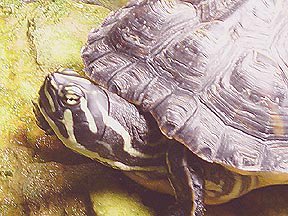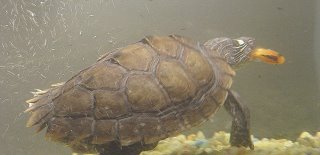skip to main |
skip to sidebar
 This is one of the two Yellow Bellied Turtles that I have right now in a twenty gallon long tank. They are pretty friendly and are hand-fed, except when I put the feeder-fish into the aquarium. They love swimming around snapping up those goldfish!
This is one of the two Yellow Bellied Turtles that I have right now in a twenty gallon long tank. They are pretty friendly and are hand-fed, except when I put the feeder-fish into the aquarium. They love swimming around snapping up those goldfish!
 I had a few box turtles in the 1980s. I tried leaving them out in the yard and they invariably would dig a whole under the fence and leave. I recovered a couple, but I wonder where the rest of them went. I hope they did OK. Keeping box turtles in a cat litter box was the other alternative. There were some large plastic contatiners that were bigger than a standard aquarium and easier to clean out because they are lighter. The box turtles never seemed very happy. Most aquatic turtles seem more sociable and happy in a clean aquarium, and they respond to me when they imagine that they are going to be fed. My box turtles on the other hand never warmed up to me. I let them have the run of the yard, so perhaps they were just not getting enough human contact? I have always liked them a lot. They are cool to watch walking around. Some day it would be nice to have some land and build a turtle habitat.
I had a few box turtles in the 1980s. I tried leaving them out in the yard and they invariably would dig a whole under the fence and leave. I recovered a couple, but I wonder where the rest of them went. I hope they did OK. Keeping box turtles in a cat litter box was the other alternative. There were some large plastic contatiners that were bigger than a standard aquarium and easier to clean out because they are lighter. The box turtles never seemed very happy. Most aquatic turtles seem more sociable and happy in a clean aquarium, and they respond to me when they imagine that they are going to be fed. My box turtles on the other hand never warmed up to me. I let them have the run of the yard, so perhaps they were just not getting enough human contact? I have always liked them a lot. They are cool to watch walking around. Some day it would be nice to have some land and build a turtle habitat.
Update: 04/16/07: Faizal recently posted a link to these cool photos of his Star Tortoise being born. The photos are very amazing, I am glad to have seen them!
 Musk Turtles are climbers! This little turtle climbed out of its aquatic habitat and then went climbing up the chicken wire. The balcony was on a second floor, so the turtle was lucky it did not go the other way and fall down to the pavement. This photo is from around 1979.
Musk Turtles are climbers! This little turtle climbed out of its aquatic habitat and then went climbing up the chicken wire. The balcony was on a second floor, so the turtle was lucky it did not go the other way and fall down to the pavement. This photo is from around 1979.
 The American crocodiles living near one Dania Beach neighborhood have been there for years, but on Monday they got plenty of media attention. BY DIANA MOSKOVITZ
The American crocodiles living near one Dania Beach neighborhood have been there for years, but on Monday they got plenty of media attention. BY DIANA MOSKOVITZ
Miami HeraldFor the three crocodiles who live in the lake at the Watermark condominiums, Monday started out as just another day in paradise. At least one of the reptilian residents took his usual morning sunbath on its usual spot, when suddenly, they became television stars.
TV news helicopters fluttered overhead. Reporters and wildlife officers appeared on the lake shore. Neighbors gathered to see what all the fuss was about. But it was much ado about nothing. Someone, it seems, had called the Broward Sheriff's Office about the crocs, thinking they were some kind of menace.
Not only were the creatures innocent of any criminal wrongdoing, they're special guests in the Dania Beach neighborhood -- protected as a federal endangered species. Only an estimated 1,000 crocodiles are left in Florida. And the Watermark crocs were not threatening anyone, said Officer Jorge Pino, spokesman for the South Florida office of the Florida Fish & Wildlife Conservation Commission.
Neighbors should be OK -- as long as they leave the animals alone, Pino said. ''All they want to do is be left alone, sun and swim,'' Pino said. ``At this point, all we have is crocodiles being crocodiles.'' If the crocs were a threat, they would be moved to a croc sanctuary near Turkey Point, in southern Miami-Dade County, he said.
The rule is different for alligators, which are not endangered but listed as threatened in Florida. More than a million alligators live in the state, Pino said. Wildlife officers will have an alligator killed if it poses a threat to people.
The Watermark crocodiles are well known, both to neighborhood residents and to wildlife officers. Biologists once tried trapping the oldest for study but failed, Pino said. ''Now our crocs are famous,'' Watermark resident Bette Weber said. ``I'm so glad they aren't taking them away.''
Two are about 9 feet long and about 9 years old, Pino said. The biggest, and oldest, is more than 13 feet long and probably more than 13 years old, he said. The oldest has been in the neighborhood for years and often could be seen skimming half-submerged in the water. His favorite sunbathing times: early in the morning and about 3 p.m., resident Della Moore said.
''My kids have known him for years,'' Moore said. The two newer crocs arrived after Hurricane Wilma, she said. The crocs stay close to the water's edge but began venturing farther onto land after Hurricane Wilma knocked down trees and the stumps were removed, Moore said.
The crocs recent appearances farther out of the water worried Joann Brave. ''If somebody came, was not aware, and disturbed it, who knows what happens?'' Brave said. Neighbors don't know the gender, calling the crocs he or she at will. A few say alligators until corrected.
American crocodiles can be distinguished from alligators by their longer, narrower snouts, greenish color and always visible teeth, University of Florida ecologist Frank Mazzotti said. American alligators have rounded snouts, are black as adults, and keep all their teeth inside with closed mouths, Mazzotti said.
The key is finding a way to live together, Pino said. It is illegal to touch, feed or harass a croc, Pino said. Staying away is key. Crocs are afraid of humans but become dangerous when they lose that fear, he said. Feeding them is worse, Mazzotti said. Then they associate people with food, which could have unfortunate consequences, he said.

 Here is my Map Turtle catching a goldfish. This turtle is named Coconut. I am not sure if it is a boy or a girl. The tail is pretty big, and that usually indicates it is a male. On the other hand, males usually have a slightly longer tail. This turtle is less than three years old. We got Coconut when it was a baby turtle at the Snakes reptile store.
Here is my Map Turtle catching a goldfish. This turtle is named Coconut. I am not sure if it is a boy or a girl. The tail is pretty big, and that usually indicates it is a male. On the other hand, males usually have a slightly longer tail. This turtle is less than three years old. We got Coconut when it was a baby turtle at the Snakes reptile store. 




